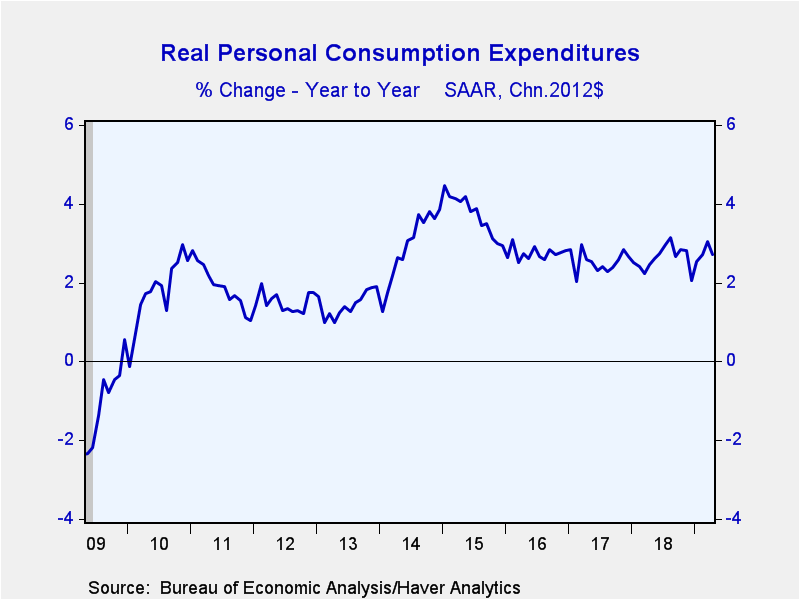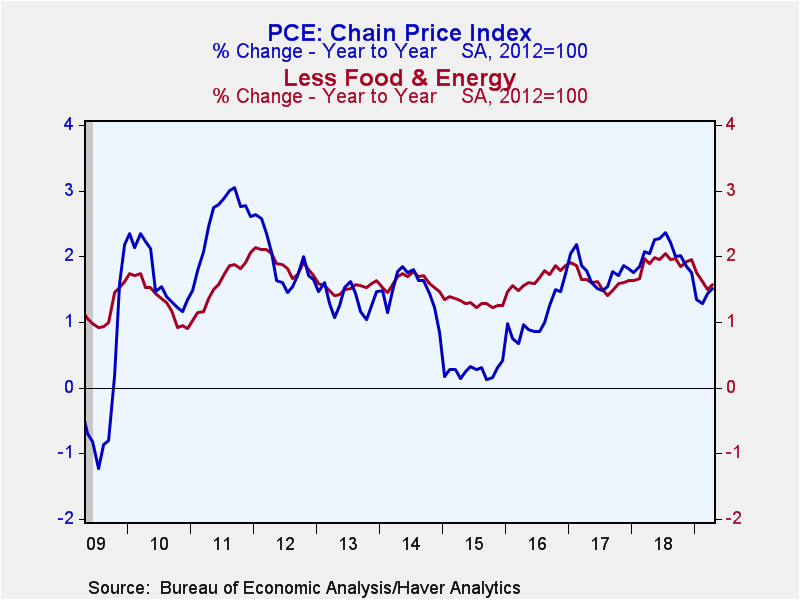 Global| May 31 2019
Global| May 31 2019U.S. Personal Spending Weakens as Price Inflation Picks Up
by:Tom Moeller
|in:Economy in Brief
Summary
Personal consumption expenditures increased 0.3% (4.3% y/y) during April following a 1.1% March gain, revised from 0.9%. A 0.2% increase had been expected in the Action Economics Forecast Survey. Nondurable goods spending strengthened [...]
Personal consumption expenditures increased 0.3% (4.3% y/y) during April following a 1.1% March gain, revised from 0.9%. A 0.2% increase had been expected in the Action Economics Forecast Survey. Nondurable goods spending strengthened 0.7% (3.8% y/y) reflecting a 6.7% rise (4.6% y/y) in spending on gasoline & other energy products. Apparel purchases held steady (2.2% y/y) after strengthening 1.3%, and spending at restaurants edged 0.1% higher (2.2% y/y) following a 1.0% rise. Outlays on services rose 0.3% (4.9% y/y) on the heels of a 0.6% surge. Recreation services spending rose 0.2% (3.3% y/y) following a 1.9% surge. Housing & utilities outlays inched 0.1% higher (4.0% y/y) following three months of strong increase. Health care spending rose a weakened 0.4% (4.8% y/y) and outlays on transportation services rose 0.3% (4.1% y/y), the same as in March. Spending on durable goods offset these gains with a 0.8% decline (+1.0% y/y) following a 3.6% surge. Spending on motor vehicle & parts weakened 2.0% (-0.3% y/y) following a 9.2% jump (1.8% y/y). Outlays on autos have declined in four of the last five months. Spending on home furnishings & appliances eased 0.1% (+1.1% y/y) after a 0.9% rise. Recreational goods & vehicle outlays fell 0.2% (+3.3% y/y) after a 0.8% rise.
The PCE chain price index rose 0.3% (1.5% y/y), the strongest increase since January of last year. The price index excluding food & energy increased 0.2% (1.6% y/y), the largest rise since December. Nondurable product prices jumped 0.5% (0.2% y/y) as fuel prices surged 5.1% (3.2% y/y), strong for a second straight month. This strength was offset by a 0.9% decline (-3.6% y/y) in the clothing & footwear price index. Food & beverage prices also were off by 0.3% (+0.8% y/y). The services price index rose 0.4% (2.4% y/y), equaling the strongest monthly rise in roughly ten years. Both transportation services and finance & insurance costs jumped 1.2% and 2.7% y/y. Recreation services prices strengthened 0.4% (2.8% y/y). Housing & utilities prices rose a steady 0.3% (3.1% y/y) but the health care price index inched just 0.1% higher (1.4% y/y) for a second straight month. A 0.4% decline (-1.8% y/y) in the durable goods price index offset some of these strong price gains, extending many years of price declines across most durable product categories.
Personal income increased 0.5% (3.9% y/y) following an unrevised 0.1% rise. The 3.9% y/y gain was below growth during 2018 and 2017. A 0.3% increase had been expected. Wages & salaries increased 0.3% but y/y growth of 3.6% remained below the 5.1% high in August 2017. Proprietors income held steady (2.3% y/y) after three straight months of decline. Rental income improved 0.2% (5.4% y/y) after three consecutive months of strong increase. Receipts on assets jumped 1.6% (2.6% y/y). A 2.3% gain (1.6% y/y) in interest income accompanied a 0.7% rise (4.0% y/y) in dividend earnings. Personal transfer receipts increased 0.6% (7.2% y/y) for the third straight month. Medicare receipts surged another 0.9% (10.6% y/y). Income from Social Security rose 0.2% (6.4% y/y), and Medicaid receipts strengthened 1.4% (5.4% y/y). Jobless insurance income declined 4.0% (-8.4% y/y) after a 0.8% drop.
In constant dollars, personal spending held steady m/m (2.7% y/y) following a 0.9% jump. Real personal disposable income rose 0.1% (2.2% y/y) after a 0.2% decline.
The strength in spending held the personal savings rate at 6.2%, below December's 7.4% high. The level of personal savings fell 5.9% y/y.
The personal income and consumption figures are available in Haver's USECON database with detail in the USNA database. The Action Economics figures are in the AS1REPNA database
Tom Moeller
AuthorMore in Author Profile »Prior to joining Haver Analytics in 2000, Mr. Moeller worked as the Economist at Chancellor Capital Management from 1985 to 1999. There, he developed comprehensive economic forecasts and interpreted economic data for equity and fixed income portfolio managers. Also at Chancellor, Mr. Moeller worked as an equity analyst and was responsible for researching and rating companies in the economically sensitive automobile and housing industries for investment in Chancellor’s equity portfolio. Prior to joining Chancellor, Mr. Moeller was an Economist at Citibank from 1979 to 1984. He also analyzed pricing behavior in the metals industry for the Council on Wage and Price Stability in Washington, D.C. In 1999, Mr. Moeller received the award for most accurate forecast from the Forecasters' Club of New York. From 1990 to 1992 he was President of the New York Association for Business Economists. Mr. Moeller earned an M.B.A. in Finance from Fordham University, where he graduated in 1987. He holds a Bachelor of Arts in Economics from George Washington University.










